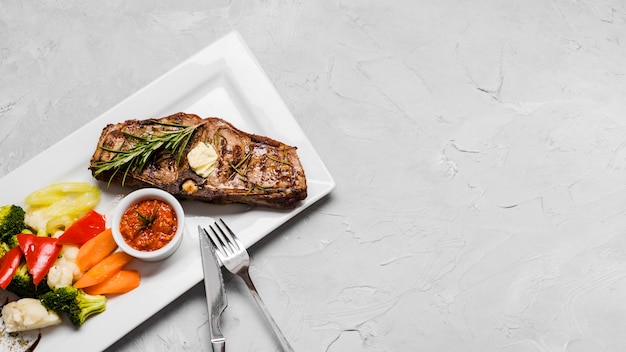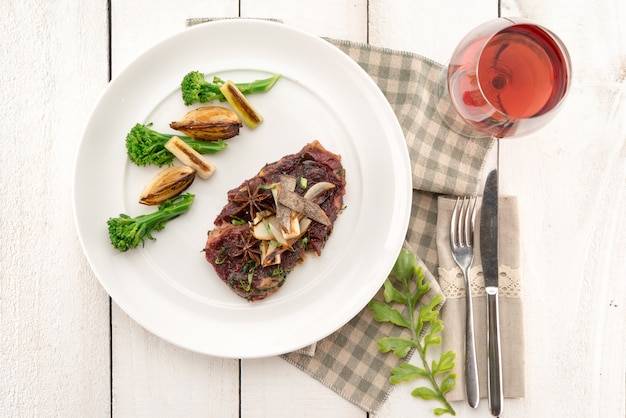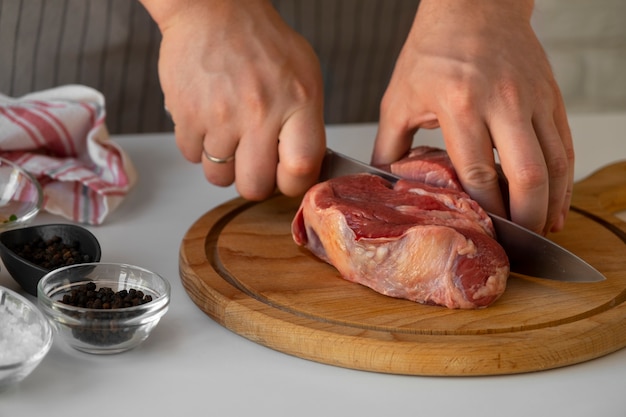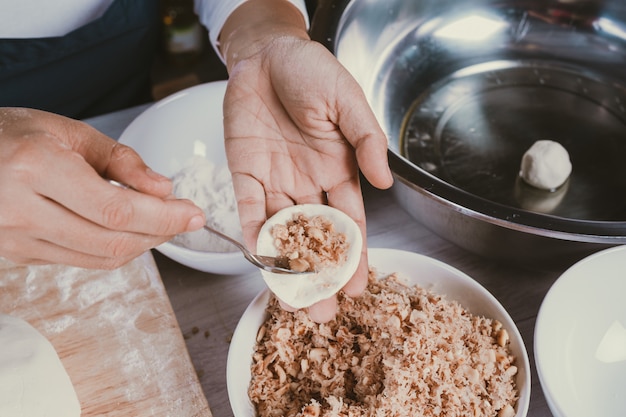Let's talk filet mignon, shall we? It’s a true culinary gem, a cut of beef that embodies pure indulgence. That melt-in-your-mouth tenderness, the rich, buttery flavour – it's simply irresistible. But let's be real, getting it perfectly cooked, that luscious medium-rare, takes more than just tossing it on the grill and hoping for the best. It requires a bit of know-how, a touch of finesse, and a healthy dose of patience. Trust me, I've learned the hard way. There's a whole world of technique and timing involved, and I'm here to guide you through it, step by step. So grab your apron, gather your culinary courage, and let's embark on a journey to filet mignon perfection together.
Part 1: The Basics of Filet Mignon

The Cut: Why Filet Mignon Reigns Supreme
First things first, why is filet mignon the king of steaks? Well, it’s the most tender cut you can find, hailing from the tenderloin, a muscle that's hardly used by the cow. It’s like a delicious little treasure hidden inside the beast. Now, you'll find beef graded in different ways, but for filet mignon, you really want to aim for Prime or Choice. These grades signify a higher fat content, resulting in a more flavorful and juicy steak. The marbling – those lovely streaks of fat throughout the meat – are key. They literally melt as the steak cooks, adding flavour and tenderness. It might cost a bit more, but believe me, the difference is noticeable.
Size Matters: Choosing the Right Filet
Filet mignon comes in all shapes and sizes, but I find a 6-8 ounce piece per person to be ideal. It's a good balance – not too small, not too big. You'll have plenty of meat to enjoy without feeling overwhelmed. But hey, if you're hosting a serious steak night with friends, go for a larger cut, no judgment here.
A Word on Thickness: It Makes a Difference
The thickness of your filet is another important factor. A thicker cut will take longer to cook, so keep that in mind. I usually go for something between 1.5 and 2 inches thick. This provides the perfect canvas for a lovely sear and a juicy, even cook.
Part 2: Prepping Your Filet - Setting the Stage for Success

Getting Ready: It's All About the Details
Okay, you've got your beautiful filet, now let's get ready to cook. First, pat it dry with kitchen paper. We don't want any excess moisture messing with our sear. Then, season generously with salt and pepper. I always use freshly ground pepper, it gives the steak a wonderful aroma and a little bit of extra kick. Feel free to experiment with other seasonings like garlic powder, onion powder, or even a touch of smoked paprika, but don't go overboard; we want to let the natural flavour of the beef shine.
Let it Rest: Patience is a Virtue
Here's a little trick I learned from my grandmother: let your filet rest at room temperature for about 30 minutes before cooking. This allows the meat to come to room temperature, which helps it cook more evenly. The idea is to prevent the steak from going into shock when it hits the heat. But remember, don’t leave it out for too long, or it'll start to get a bit on the warm side.
The Secret Ingredient: A Little Olive Oil
Before you start cooking, give your filet a gentle drizzle of olive oil. This helps create that beautiful crispy sear and adds even more depth of flavour. Use a good quality extra virgin olive oil – it makes all the difference.
Part 3: Cooking Time - Mastering the Art of Medium-Rare

The Grill: Embracing the Heat
I'm a huge fan of the taste of grilled filet mignon. There’s something about the smoky aroma and those perfect grill marks that just elevate the flavour. If you're grilling, aim for medium-high heat. You want those iconic grill marks, but you also don't want to burn the outside. Cook for about 2-3 minutes per side for medium-rare. Flip your steak with a good pair of tongs to ensure you don't pierce it and lose valuable juices.
The Pan: The Classic Approach
If you prefer a pan-seared filet, heat your pan over medium-high heat. Let it get really hot, then add your filet. Cook for about 3-4 minutes per side, or until you have a beautiful crust. Don't move it around too much, let it sit there and sear. You'll hear a lovely sizzling sound – that's the magic happening, those lovely Maillard reactions building flavour.
The Oven: Finishing it Off
Once you've achieved that gorgeous sear, transfer your filet to a preheated oven for about 5-7 minutes at 375°F. This will cook the center to your desired doneness. But remember, ovens can vary, so keep a close eye on it. You don't want to overcook your beautiful steak.
Part 4: Checking for Doneness - No More Guesswork
The Finger Test: A Tried and True Method
So, you've got your filet cooking, but how do you know when it's done? You can use a meat thermometer, of course, but I also love the finger test. It's a bit old-school, but it works. Just poke the center of your steak with your finger. It should feel firm, but still give a little bit. You can compare the feel to the fleshy part of your palm to get an idea of the doneness. For example, if it feels like the pad of your thumb, it's likely medium-rare.
The Temperature Guide: For the Scientifically Inclined
If you prefer a more precise method, use a meat thermometer. Here's a temperature guide to help you out:
| Doneness | internal temperature (°F) |
|---|---|
| Rare | 125-130 |
| Medium-Rare | 130-135 |
| Medium | 140-145 |
| Medium-Well | 150-155 |
| Well Done | 160 |
Remember, these are just guidelines. Your personal preference for doneness might be different. Just make sure you cook the filet to your liking.
Part 5: Resting the Filet - The Art of Patience
Once you've cooked your filet to perfection, don't be tempted to dig in right away. It needs to rest for about 5-10 minutes before slicing. This allows the juices to redistribute throughout the meat, ensuring it stays tender and juicy. Think of it as a little time for the steak to relax and recover from its culinary adventure.
How to Rest: The Right Way
Cover the filet loosely with foil and let it rest on a cutting board. This will keep it warm while it's resting, preventing it from getting too cold.
Why Resting Matters: A Scientific Explanation
When you cook a steak, the heat causes the juices to migrate towards the center. As the steak rests, the juices have time to spread out evenly throughout the meat. This results in a juicier, more flavorful steak.
Part 6: Slicing Your Filet - The Art of the Cut
Okay, you've waited patiently, now it's time to enjoy the fruits of your labour. Here's how to slice your filet like a pro:
The Technique: Cutting Across the Grain
First, cut your filet against the grain. This means slicing perpendicular to the muscle fibers. Think of those fibers as little ropes that run through the steak. By cutting across them, you make the steak easier to chew and allow you to enjoy its tender texture.
The Thickness: A Matter of Taste
Cut your filet into slices about 1/2 inch thick. This will allow you to enjoy the full flavour and texture of the steak.
Part 7: Serving and Enjoying - The Grand Finale
You've done the hard work, now it's time to enjoy your beautifully cooked filet mignon.
side dishes: Completing the Meal
Filet mignon is so delicious on its own, but it's always nice to have a few side dishes to complement the flavours. Here are a few ideas:
- Creamy mashed potatoes: The classic combination that never fails.
- Roasted vegetables: Asparagus, broccoli, or Brussels sprouts go beautifully with steak.
- A simple salad: A light salad adds a refreshing contrast to the richness of the steak.
- Garlic bread: A warm and comforting accompaniment to your steak.
- Risotto: A creamy and flavorful rice dish that pairs beautifully with the richness of the filet.
Sauce It Up: Adding a Touch of Elegance
Want to add a touch of elegance to your steak? Try a simple sauce. Here are a few of my favourites:
- Béarnaise sauce: Rich, creamy, and perfect for filet mignon. It's a classic French sauce made with egg yolks, butter, vinegar, and herbs.
- Red wine sauce: A classic and sophisticated choice. This sauce is made with red wine, shallots, and herbs.
- Garlic butter sauce: Simple, delicious, and always a winner. It's as simple as it sounds: garlic, butter, and a touch of lemon juice.
- Mushroom sauce: A rich and earthy sauce that complements the flavor of the filet mignon beautifully.
- Peppercorn sauce: A spicy and flavorful sauce that adds a kick to your steak.
Raising a Glass: Celebrating the Occasion
No steak dinner is complete without a good glass of wine. Here are a few suggestions to pair with your filet mignon:
- Cabernet Sauvignon: A bold and full-bodied red that complements the richness of the steak. It has notes of blackcurrant, cedar, and vanilla.
- Pinot Noir: A lighter red with fruity notes that pair well with the tenderness of the filet. It's known for its cherry, strawberry, and earthy flavors.
- Chardonnay: A crisp and refreshing white that can also complement a filet mignon. Look for a Chardonnay with notes of apple, pear, and citrus.
- Merlot: Another full-bodied red wine that pairs well with the richness of the filet mignon. It often has notes of plum, cherry, and chocolate.
- Syrah/Shiraz: This red wine has a bold and peppery flavor that complements the richness of the filet mignon.
The Moment of Truth: Savor the Experience
You've put in the effort, now it's time to sit back and enjoy your beautifully cooked filet mignon. Take your time, savor every bite, and let the delicious flavours melt in your mouth.
Part 8: FAQs: Filet Mignon Questions Answered
1. How can I prevent my filet mignon from drying out?
The key to preventing a dry filet is to cook it to the right temperature and to rest it properly. Overcooking can lead to dryness, so make sure you use a meat thermometer to ensure you don’t cook it past medium-rare. Resting the filet for 5-10 minutes after cooking allows the juices to redistribute, ensuring it stays moist and tender.
2. What’s the best way to sear a filet mignon?
For a beautiful sear, use a cast iron skillet or a grill over medium-high heat. Let the pan or grill get really hot, then add your seasoned and oiled filet. Don't move it around too much, let it sit and sear for about 3-4 minutes per side. The key is to create a beautiful crust without burning the meat.
3. Can I cook a filet mignon in the oven?
Absolutely! You can cook a filet mignon in the oven by first searing it in a pan, then transferring it to a preheated oven at 375°F for 5-7 minutes. This will cook the center to your desired doneness while maintaining the delicious sear on the outside.
4. What are some good side dishes to serve with filet mignon?
Filet mignon is a versatile steak that pairs well with a variety of side dishes. Here are a few ideas:
- creamy mashed potatoes
- Roasted vegetables
- A simple salad
- Garlic bread
- Risotto
- potato gratin: A rich and cheesy potato dish that complements the filet mignon perfectly.
- Mac and cheese: A classic comfort food that pairs well with steak.
5. What are some good wine pairings for filet mignon?
A bold red like Cabernet Sauvignon or Merlot is a classic pairing for filet mignon. If you prefer a lighter red, Pinot Noir or Zinfandel are also good options. For a white wine pairing, try a crisp Chardonnay or Sauvignon Blanc.
There you have it! Your complete guide to cooking the perfect filet mignon. Now go out there and impress your guests with your culinary skills. Happy cooking!
Everyone is watching

How to Cook Frozen Lobster Tails Perfectly: A Step-by-Step Guide
RecipesLobster. Just the word conjures up images of lavish meals, special occasions, and a taste of luxury. But let's...

Pigs in a Blanket Cooking Time: How Long to Bake for Perfect Results
RecipesAh, pigs in a blanket. Just the name conjures up images of those delightful little parcels of crispy pastry en...

Pork Fillet Cooking Time: How Long to Cook It Perfectly
RecipesPork fillet, or tenderloin as it's sometimes called, is a real favourite in our house. It's so versatile, and...

The Ultimate Guide to Cooking Delicious Frankfurters
RecipesLet's face it, we all love a good frankfurter. It's a classic, simple, and always satisfying. But let's be rea...

The Ultimate Guide to Tender, Juicy Pulled Pork
RecipesRight, let's talk pulled pork. It's one of those dishes that just screams "comfort food," doesn't it? I mean...
